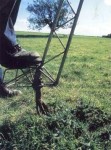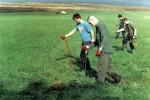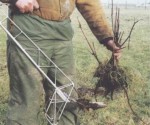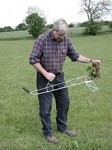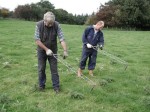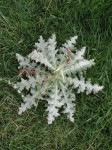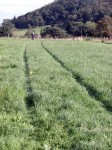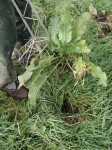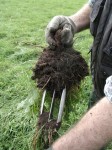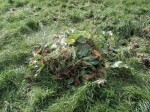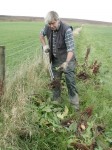THE REMOVAL OF INDIVIDUAL PLANTS ( 'RIP' ) Using the Lazy Dog (L-D) method
The use of modern hand-tool technology, is proving to be an excellent alternative (or just follow-up), to chemical weeding. On our organic farm in North Yorkshire, where the no-bend L-D tools are developed and made, weeds have for years been controlled in fields, pasture & common land, mainly using 'RIP'.
In 2000, L-D started demonstrating this method at some 25 different sites nationwide. Those weeding contracts, which were recorded, lead to the kick-starting of other contract weeding gangs, nationwide.
This project, which has been DEFRA funded, involves L-D demonstrations and start-up packages. Even though there remain problems associated with full or part-time hand labour (e.g. finding, organising, leading), land managers must be made aware of the advantages associated with RIP.
Experience of applying 'RIP' has been informative
Docks, Spear thistle, Ragwort can and should be 90% controlled outside the growing season, when the ground is moist, the plants small, the sun cooler, the pressure less. Canadian (or creeping thistle), can be controlled by chiselling the 5" rosette below the point of growth, especially on drier sites. No two sites (or their conditions) are ever exactly the same Each weeding job requires a strategic and methodical approach, after a thorough site inspection. A work force has to be well organised, motivated, and skillfully lead, (we use 4 or 5 man gangs). Realistic cost-assessment methods & work-rates have been worked out and published. Experienced, educated and careful land management is the vital ingredient behind weed control (before or after applying RIP). 'Crop cover' is the operative word. Dock beetle-grubs (& others), can be of great assistance in that land management. New L-D tools enable a work force to work long days, repeatedly. RIP can also be misapplied in the wrong conditions / situations (see limitations overleaf). With the application of 'RIP', there is…
no waiting for appropriately dry or still conditions (to knapsack or boom spray). no need to remove of stock from the site (except that Ragwort must be collected). no need to spend time ordering or mixing a host of different chemicals no need to let plants grow tall enough to weed-wipe or grab (as with some tools). no need to watch seed heads approach maturity (as with some chemicals). no need to find purchase costs of chemicals or maintenance costs of machinery. no need for expensive protection against chemicals, or planned disposal of cans to landfill. no safety inspections or records to fill in. There are other vital but less obvious advantages:
Pastures can be mostly cleared before the growing season. It is easy to be selective (between species) or deal with any number of different weeds during one walk over the land. This sort of flexibility requires a hotchpotch of different chemicals. It is easy to notice non-target plants (e.g. Ragwort rosette, among the unwanted thistles in pasture). It is easy to notice unusual and important ecological details (plant life, bugs & birds). There is no interference with soil bacteria, watercourses, the flora, fauna, or spray operator. Chemicals are not applied to whole areas (as with boom spraying), where weeds may be few or spaced out. What then, are the limitations of RIP?
A workforce has to be found, organised, motivated and paid. A workforce of 4 seems ideal for obtaining accurate coverage. Ideally, organise your own local gang, possibly with help from your local machinery ring. Ask us to demonstrate. Do this well in advance of the best weeding period Expect to pay up around £7 per hour per man (£56 for 8 hrs on site or 7 hrs lifting). Six consecutive weeks on three sites (pulling Ragwort & docks), is the longest that our contract gangs have worked for. More limitations If weed densities are very high (e.g., over 200 to 25 metres sq.), RIP may be inappropriate Pulling dwarf-sized docks in overgrazed pasture can make slow progress. Pulling docks from arable land requires digging deep to find the broken root section. L-D have made a specialist long-reach tool for this work. On arable clay it is best to wait for a dry day. Drought conditions in clay combined with flowering weeds (e.g. Ragwort), make unnecessarily hard work. (Pull most of them as rosettes, earlier in season) When mistakes occur (e.g. serious loss of crop cover in organic farming), it is important to know when to cut losses by using a mower, topper, forage harvester, plough, to avoid maturing seed-heads. Legitimate fears Legitimate fears, that the levering out of plants can expose a hidden seedbank (especially on overgrazed Ragwort pastures), are being put to the test. (see the report of our trial at Thixendale, N. Yorks.). Healing in the broken turf is always a sensible precautionary measure. The amount of annual 'follow-up' varies with the quality of post-weeding management (depth of sward, grazing patterns). Some follow-up is almost inevitable in the Spring, but it becomes much less annually. Of course, this is also a common occurrence after chemical applications. Some (but not all) jobs will obviously take longer than boom spraying or weed-wiping, and will cost more (in cash terms). Gangs and their leaders have to be taught to recognise plants at different stages of their growth Lazy Dog Tools are keen to teach & inspire gang leaders
Demonstrations can always be arranged, so see our list of Weeding Brigade Lazy Gang contacts
This website includes detailed reports of 25 monitored sites and trials. Ragwort, Docks, Spear thistle, Creeping thistle are covered in arable, permanent pasture, new & old wildflower meadows (countryside stewardship) in both conventional and organic systems.
See our list of coming demonstrations & trials
